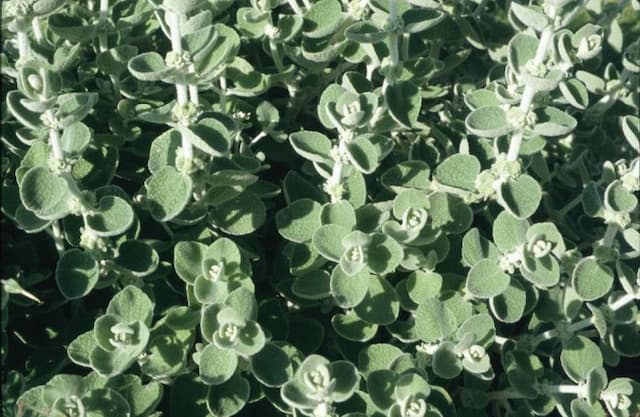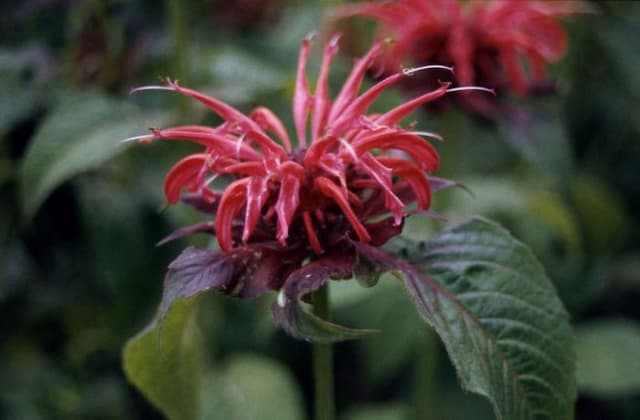Anise Hyssop Agastache 'Blue Fortune'

ABOUT
Agastache 'Blue Fortune' is a perennial plant that is known for its attractive flower spikes and aromatic foliage. This plant showcases a plethora of small, tubular flowers that are a deep lavender-blue hue, forming dense, showy spikes that rise above the foliage from mid to late summer. The flowers are loved by pollinators, such as bees, butterflies, and hummingbirds, and they lend a vibrant splash of color to gardens. The foliage of Agastache 'Blue Fortune' consists of lance-shaped leaves that exhibit a bright green color with a slightly rough texture. When they are crushed or brushed against, the leaves release a delightful fragrance, often compared to licorice or anise, which contributes to the sensory appeal of the plant. The overall habit of the plant can be described as upright and bushy, with the flower spikes creating a striking vertical element in the garden landscape. Due to its showy nature and pleasantly scented leaves, Agastache 'Blue Fortune' is a favored choice among gardeners who wish to create visually arresting borders, herb gardens, or pollinator-friendly spaces. Even when not in bloom, the plant's textured foliage maintains visual interest throughout the growing season.
About this plant
 Names
NamesFamily
Lamiaceae
Synonyms
Anise Hyssop, Blue Fortune Giant Hyssop, Fragrant Giant Hyssop
Common names
Agastache 'Blue Fortune'
 Toxicity
ToxicityTo humans
The Agastache 'Blue Fortune', commonly known as anise hyssop, is not known to be toxic to humans. Generally, it's considered safe when used in the appropriate culinary or medicinal quantities. There are no widely recognized symptoms of poisoning, as it is not considered a poisonous plant.
To pets
Anise hyssop is also not known to be toxic to pets. It is not listed as a poisonous plant for cats or dogs by the ASPCA or other leading pet health organizations. Therefore, there should be no symptoms of poisoning in pets due to ingesting parts of the anise hyssop plant under normal circumstances. However, any plant material, if ingested in large quantities, could potentially cause gastrointestinal upset in some pets.
 Characteristics
CharacteristicsLife cycle
Perennials
Foliage type
Deciduous
Color of leaves
Green
Flower color
Blue
Height
2-3 feet (60-90 cm)
Spread
2-3 feet (60-90 cm)
Plant type
Herb
Hardiness zones
5-9
Native area
North America
Benefits
 General Benefits
General Benefits- Attracts pollinators: Agastache 'Blue Fortune' is known for attracting bees, butterflies, and other beneficial insects to the garden.
- Drought resistant: Once established, it is quite tolerant to drought, making it suitable for xeriscaping and low-water gardens.
- Aromatic foliage: The leaves have a pleasant scent which can add an aromatic dimension to gardens and outdoor spaces.
- Long blooming season: It produces flowers for an extended period, typically from midsummer to early fall, providing long-lasting visual interest.
- Deer resistant: The plant is not a preferred food source for deer, which makes it a good choice for gardens in areas with deer pressure.
- Low maintenance: Requires minimal care once established, with no significant pest or disease issues, making it an easy plant for gardeners of all levels.
- Ornamental qualities: Offers aesthetic value with its long, dense flower spikes of lavender-blue flowers and anise-scented foliage.
- Culinary uses: Some Agastache species have edible flowers and leaves that can be used in teas, salads, and as garnishes.
 Medical Properties
Medical Properties- Agastache 'Blue Fortune' is not used for medical purposes.
 Air-purifying Qualities
Air-purifying QualitiesThis plant is not specifically known for air purifying qualities.
 Other Uses
Other Uses- Agastache 'Blue Fortune' can be used in potpourri as its leaves retain a pleasant aroma even when dried.
- Insect repellent sachets often incorporate the leaves of Hyssop due to their strong scent that can deter pests from clothing or linens.
- Dried Hyssop flowers can serve as a natural dye source for fabrics, yielding shades of yellow to green depending on the mordant used.
- Artisanal cheese makers sometimes infuse cheeses with Hyssop flowers to impart a unique floral note to the product.
- The plant can be incorporated into a green roof design for both aesthetic value and to attract pollinators to urban environments.
- Hyssop can be used as a companion plant in the garden to attract beneficial insects and improve the growth of vegetables and fruits.
- Flower arrangers may use the tall, spiky inflorescences of Hyssop in fresh or dried floral arrangements for its texture and pop of color.
- In landscape design, Hyssop can function as a natural border or hedge, providing structure and height to garden beds.
- The aromatic foliage of Hyssop can be used to stuff small pillows or scented toys, offering a mild, calming fragrance.
- Culinary enthusiasts sometimes use the anise-flavored flowers of Hyssop to infuse syrups or spirits, adding a herbaceous twist to cocktails or desserts.
Interesting Facts
 Feng Shui
Feng ShuiThe Agastache, commonly known as Hyssop, can be used in Feng Shui for its purifying qualities that improve the flow of Qi, particularly by adding the wood element with its upright growth and enhancing the blue-green color scheme in a garden to evoke a sense of tranquility and support spiritual healing.
 Zodiac Sign Compitability
Zodiac Sign CompitabilityThe Hyssop is not used in astrology practice.
 Plant Symbolism
Plant Symbolism- Healing: Agastache, commonly known as Anise Hyssop or Hummingbird Mint, is often associated with healing properties due to its use in traditional medicine.
- Protection: The robust scent of Anise Hyssop is believed to ward off negative energy and protect individuals from harm.
- Purification: With its refreshing aroma, Anise Hyssop is sometimes used in cleansing rituals and to purify spaces.
- Love: The attractive and bright flowers are symbolic of love and can represent an individual's quest for a romantic connection.
- Harmony: Anise Hyssop's presence in a garden is thought to encourage balance and harmony within the natural ecosystem, as it attracts pollinators like bees and butterflies.
- Intuition: Because of its aromatic qualities, the plant is linked with enhancing intuition and mental clarity.
 Water
WaterTo water Hyssop 'Blue Fortune', it is essential to maintain a balance, as the plant prefers well-drained soil and does not tolerate over-watering. During the growing seasons of spring and summer, water the plant thoroughly once a week, making sure to soak the soil to a depth of about an inch. Allow the soil to dry slightly between waterings. In hotter, dryer climates, you may need to water twice a week. When established, Hyssop 'Blue Fortune' is drought tolerant and requires less frequent watering. Provide about one gallon of water per plant for each watering session, ensuring consistency for optimal health and growth.
 Light
LightHyssop 'Blue Fortune' thrives best in full sun conditions, requiring at least six hours of direct sunlight each day. The ideal spot for this plant is in an area where it can receive unfiltered sunlight throughout the majority of the day. While it can tolerate some light shade, too much shade can lead to poor flowering and a leggy growth habit.
 Temperature
TemperatureHyssop 'Blue Fortune' is a hardy plant that can withstand temperatures as low as 15 degrees Fahrenheit but thrives in temperatures ranging from 60 to 80 degrees Fahrenheit. It can also tolerate high temperatures well, as long as it receives sufficient water. To protect the plant from extreme cold, it is best to plant it in a location that is sheltered from harsh winds.
 Pruning
PruningPruning Hyssop 'Blue Fortune' is important to maintain its shape, encourage bushier growth, and promote more vigorous flowering. Prune the plant in early spring before new growth begins, cutting back the previous year's growth by about one-third. Deadheading, or removing spent flowers, can be done as needed throughout the growing season to encourage additional blooms. The best time for major pruning is when new growth appears at the base of the plant, typically in late winter to early spring.
 Cleaning
CleaningAs needed
 Soil
SoilFor Anise Hyssop 'Blue Fortune', a soil mix that provides good drainage is best. A mix composed of garden soil, compost, and perlite or sand would be ideal. The optimal soil pH would be slightly acidic to neutral, ranging from 6.0 to 7.5.
 Repotting
RepottingAnise Hyssop 'Blue Fortune' does not require frequent repotting and should be repotted every few years as it outgrows its container or when the soil becomes depleted.
 Humidity & Misting
Humidity & MistingAnise Hyssop 'Blue Fortune' thrives in average to low humidity conditions and does not require high humidity levels to grow well.
 Suitable locations
Suitable locationsIndoor
Place in bright light and well-draining soil.
Outdoor
Full sun, well-drained soil, water when dry.
Hardiness zone
5-9 USDA
 Life cycle
Life cycleAgastache 'Blue Fortune', commonly known as Anise Hyssop or Hummingbird Mint, begins its life cycle as a seed that germinates when temperatures warm in spring. As a perennial, it develops a root system and foliage during the first year, but may not bloom until the second season. After the establishment, the plant enters a growth phase each spring, producing square stems with opposite leaves and terminal spikes of lavender-blue flowers that are highly attractive to bees and butterflies. The blooming phase typically occurs from mid-summer to early fall when the plant reaches peak aesthetic appeal. As the growing season ends, the plant goes dormant, with above-ground growth dying back and the roots surviving through winter. The cycle recommences with new growth from the rootstock as temperatures rise again in the following spring.
 Propogation
PropogationPropogation time
Spring-Early Summer
Propogation: Agastache 'Blue Fortune', commonly known as Anise Hyssop 'Blue Fortune', is typically propagated by seed. The ideal time for sowing seeds is either in late winter for spring planting or directly outdoors after the danger of frost has passed. To propagate by seed, one must first ensure a well-draining soil mix. The small seeds should be sown on the soil surface and not covered, as they require light to germinate. Keeping the soil consistently moist but not waterlogged is crucial for successful germination, which can take 14 to 30 days at a temperature around 70°F (approximately 21°C). Once seedlings have developed a couple of true leaves, they can be transplanted to individual pots and later moved to their final position in the garden.









